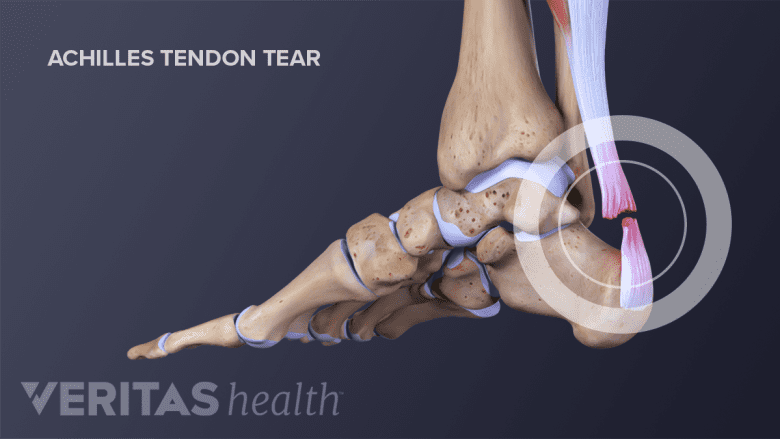Pain at the back of the ankle or lower calf may signal a problem with an Achilles tendon. Athletes who participate in track and field, soccer, volleyball, softball, and racquet sports, such as tennis, are particularly susceptible.1Maffulli N, Sharma P, and Luscombe K. Achilles tendinopathy: aetiology and management. J R Soc Med. Oct 2004; 97(10): 472–476. doi: 10.1258/jrsm.97.10.472
Tendons are tough bands of tissue that connect muscles to bones. The Achilles tendon connects the calf’s gastrocnemius and soleus muscles to the calcaneus, or heel bone. One of the longest tendons in the body, the Achilles tendon is essential for walking and running, making it susceptible to significant wear and tear.
In This Article:
Achilles Tendonitis and Other Conditions Defined
An inflamed Achilles tendon causes increased pain and stiffness during foot movements.
There are different tendon conditions that can cause Achilles tendon pain:
- Tendonitis is inflammation of the tendon. Achilles tendonitis tends to be an acute (or quick-onset) condition lasting 6 weeks or less. Some practitioners view this diagnosis as the first in a continuum of tendon injuries that subsequently increase in severity.
- Tendinosis is a non-inflammatory degeneration of the tendon. It typically occurs due to long-term overuse of the tendon, which can lead to weakening on the tendon fibers.
- Paratenonitis is inflammation of the tissue surrounding the tendon, which may thicken and adhere to tendon. This diagnosis is controversial, as some practitioners do not believe paratenonitis is a separate condition from tendonitis.
- Insertional Achilles Tendinopathy is inflammation, and later, degeneration of the tendon fibers that insert on the back of the heel bone (calcaneus).
Some doctors describe these conditions as part of the spectrum of Achilles tendinopathy, while other doctors only use the term tendinopathy when a tendon fails to heal. Patients diagnosed with Achilles tendinopathy are encouraged to ask their doctors about the details of their Achilles tendon condition.
See What Is the Difference Between Tendonitis, Tendinosis, and Tendinopathy?
Achilles Tendon Tears
A sudden injury can tear the Achilles tendon, causing difficulty in walking or standing.
People with Achilles tendonitis and other tendon conditions are susceptible to acute tears.
An Achilles tendon tear is typically a single, sudden traumatic event. For example, a person may be running and come to a sudden stop or pivot quickly mid-stride to change direction, straining and tearing the tendon. The patient may feel or hear a “pop” when the tear occurs, followed by strong, sudden pain.
Patients with acute tears or ruptures to the Achilles tendon usually find it difficult to walk or stand. People who have torn their Achilles tendons may not be able to walk or stand and may require surgery.
- 1 Maffulli N, Sharma P, and Luscombe K. Achilles tendinopathy: aetiology and management. J R Soc Med. Oct 2004; 97(10): 472–476. doi: 10.1258/jrsm.97.10.472
Editor’s Top Picks
- What Is the Difference Between Tendonitis, Tendinosis, and Tendinopathy?
- Heel Drop Stretch for Achilles Tendonitis Pain Relief Video
- Pros and Cons of Using PRP for Tendon Injuries
- PRP Therapy for Chronic Tendon Injuries
- Stem Cell Therapy for Sports Injuries
- A Gentle Stretch for Achilles Tendonitis Video







